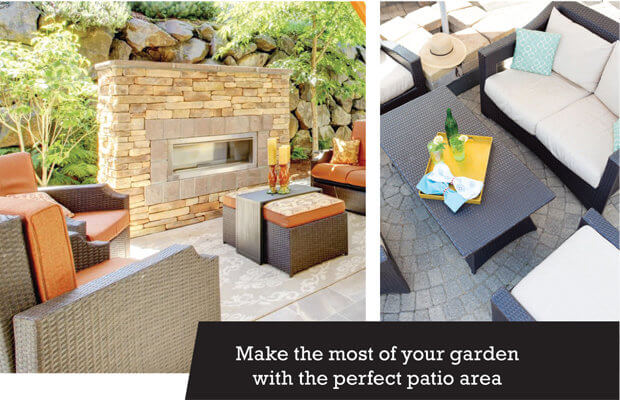Get a Perfect Patio

With longer, warmer evenings, the next few months will mean more time spent in the garden. And if you want to sit and relax in style, you’ll need to give some thought to your patio.
There are many things to consider when planning a patio, not least of which is where best to put it. We spoke to local garden design expert Julian Cant from Tierra Designs about how to plan and design a patio to get it just right.
What stone is best?

There are many, many types of stone to choose from, and sometimes it can be mind-boggling deciding which is the best one for your garden. First, you need to be clear on the look you want. If your property is Victorian, for example, a traditional look is probably more in keeping with the house. But if your home is a more generic, 1970s build, almost anything can go.
‘Often, your house will give you a feel of what sort of patio you want,’ says Julian. ‘If you have an old house you might want to splash out on expensive reclaimed York stone. This is an old stone that was traditionally used in places like churchyards and mills that has been reclaimed – it can look great with an older property because it looks as though it has always been there, and it doesn’t need time to weather. But it’s also one of the most expensive choices, which means for a newer property it might not be worth the expense. A more modern property might look better with a more modern stone.
‘We always try to stick with stones indigenous to the UK as they tend to look more in keeping. However imported stones such as Indian sandstone and limestone are popular too and do tend to be cheaper.’
Where should the patio go?
Most people have their patio right next to the house, outside the patio or bi-fold doors. But, warns Julian, care must be taken when planning this as it can go wrong.
‘Firstly, it’s better when planning a patio to make sure it’s totally surrounded by low-level planting,’ he suggests. ‘If your patio is directly outside the house, it doesn’t look good butted right up against the house, or even up against the lawn without any planting. We always try and plan some planting round the edge, with just a small neck of patio where the doors open.’
Also consider the amount of natural sunlight or shade on the patio itself as some stones are more suitable under certain conditions than others. ‘Stones such as black basalt, new York stone or reclaimed York stone work well in shady areas as they weather well,’ explains Julian.
‘But if you want something lighter and more porous, such as limestone or sandstone, you’ll need direct sunshine as in the shade they’ll need too much maintenance to keep clean.’
The same goes for those wishing to use the same stones indoors as outdoors. This is rarely a good idea, says Julian. ‘People sometimes want the same stone outside on the patio as they have chosen for inside their home to make it look like an extension of the room,’ he explains.
‘The problem is, when they weather outside, most stones change colour fairly quickly, so they don’t look the same any more as the ones inside haven’t changed.’
DIY or call in the experts?
As a DIY job, laying a patio is possible, but it’s also very easy to get it wrong – and it can be a very expensive mistake to make!
‘Getting the right surface to lay the stones on can be hard,’ says Julian. ‘Never lay directly on to sand, despite what some guides may tell you. Sand moves around, and it doesn’t stop things getting underneath the stones such as ants and roots which can damage them over time.
‘We use something called ‘mot type 1’ which they use under roads, with a wet mortar mix underneath. This is free draining and stops anything getting underneath the stones.
‘Pointing is also tricky to get right – and if you don’t get it right you could damage the stones you’ve spent a lot of money on,’ he says.
Dressing the patio
A patio is much better when surrounded by planting – it softens it, and means when you’re sitting on it you truly feel as though you’re in the garden.
‘If you’re planning a patio from scratch, try to factor in low-level planting at the beginning,’ suggests Julian. ‘I don’t like pots very much as they damage the stone, but if you do want pots, plan them in at this stage rather than just leaving it until the last minute as they will work much better.’


